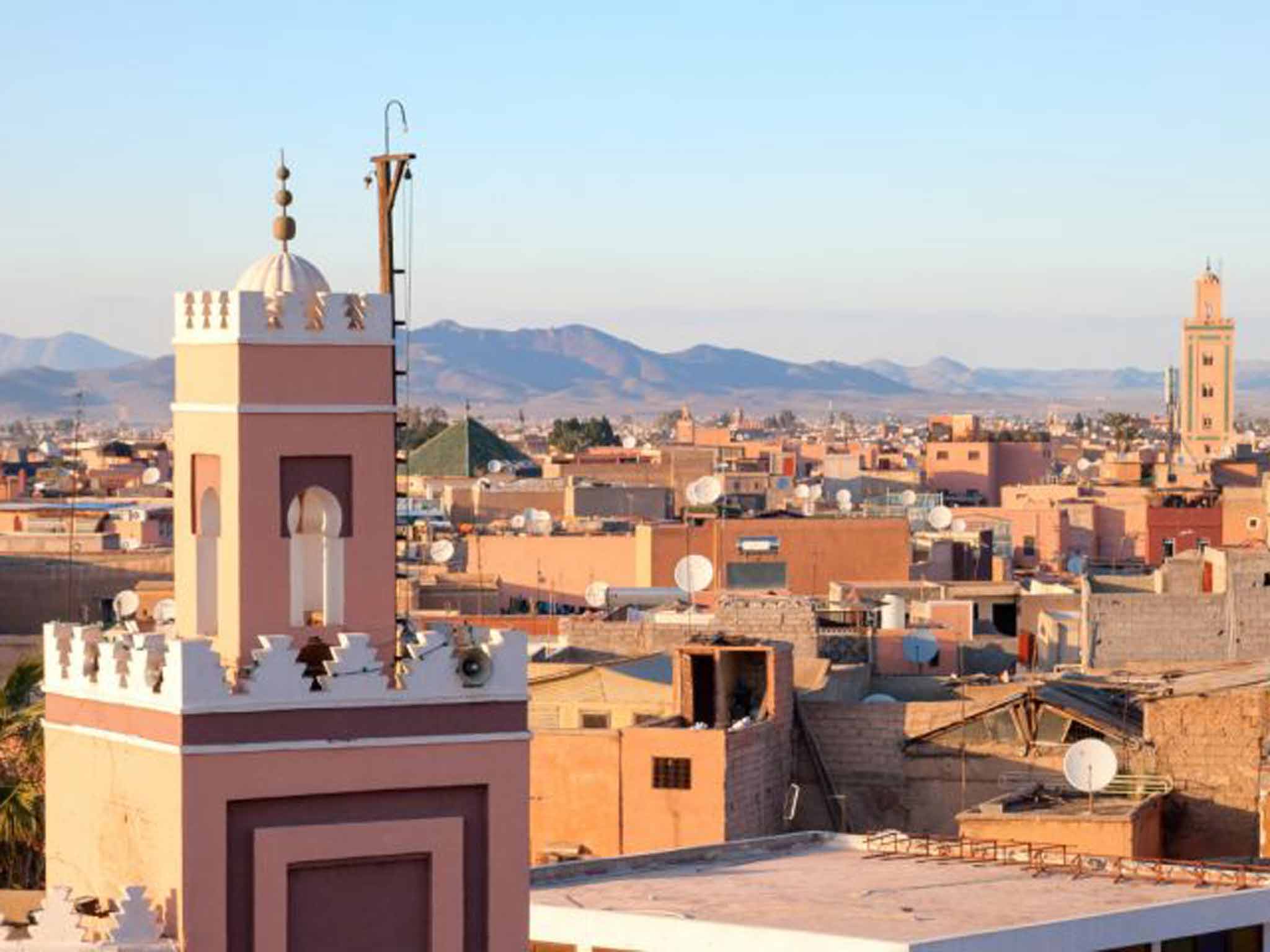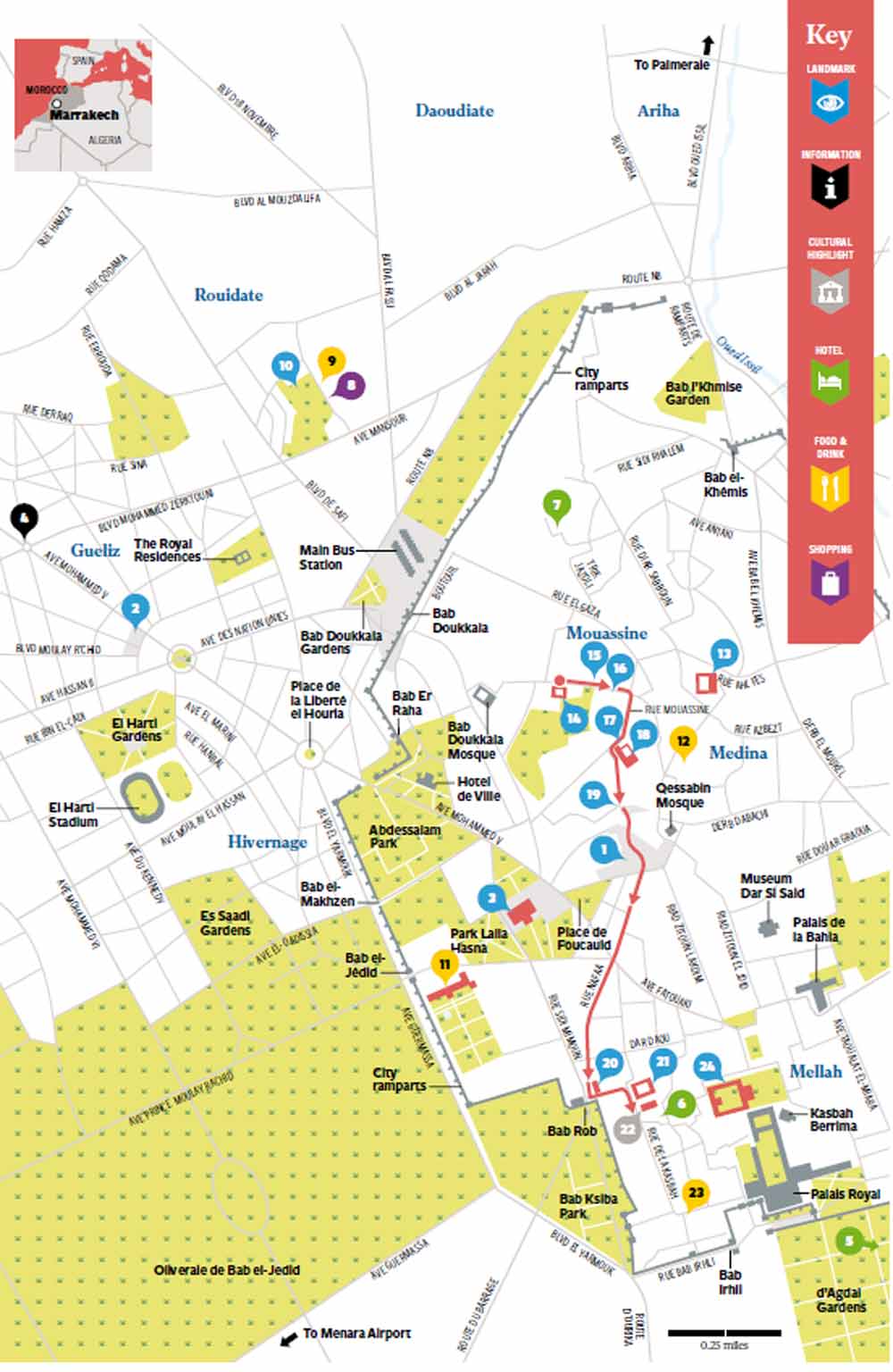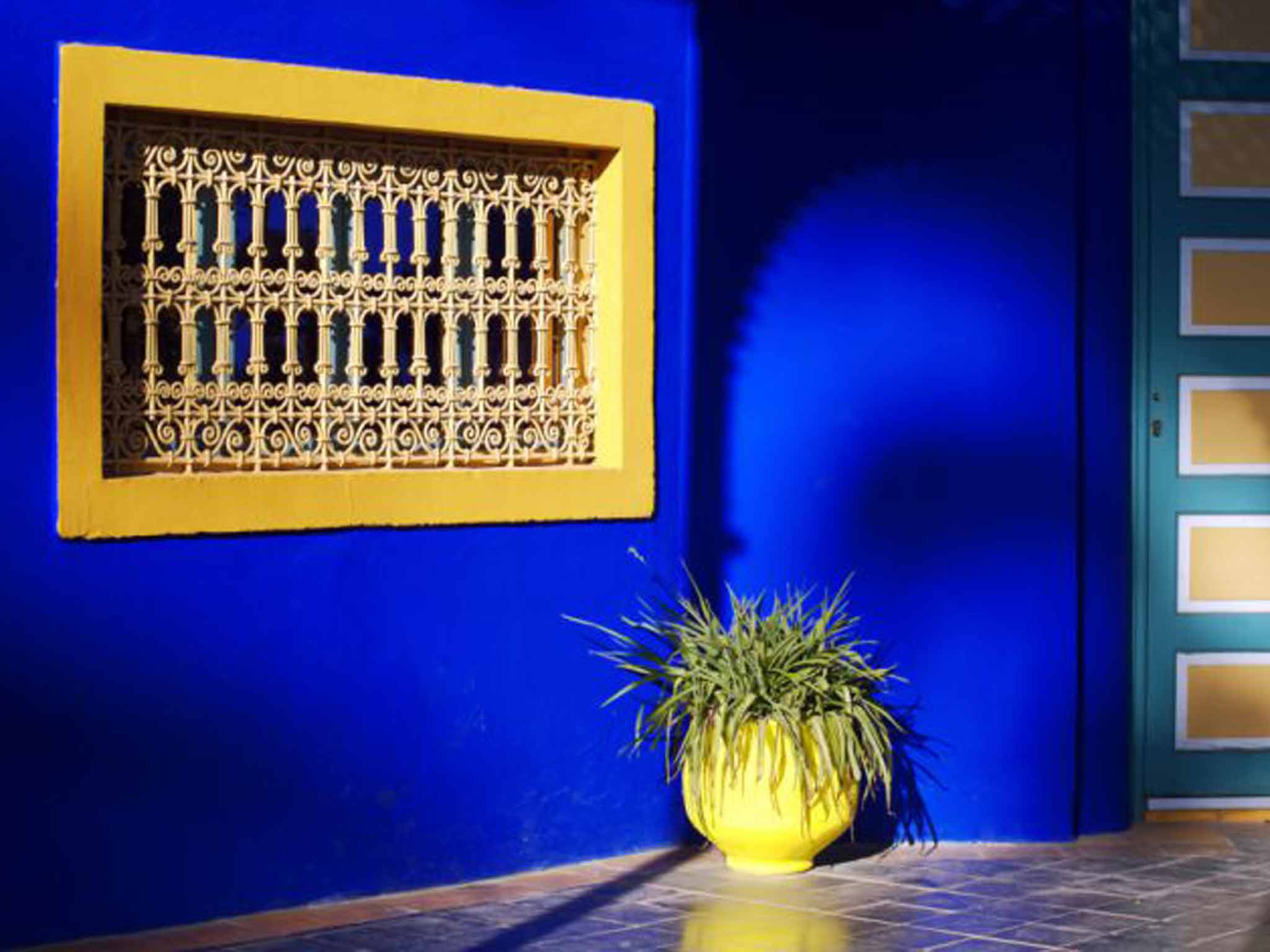The Independent's journalism is supported by our readers. When you purchase through links on our site, we may earn commission.
Marrakech travel tips: Where to go and what to see in 48 hours
Morocco's Rose City offers a welcome dose of sunshine, souk stalls in serpentine alleys, and the towering Koutoubia Mosque, as Aoife O'Riordain discovers

Travel essentials
Why go now?
Marrakech is the ideal place for a blast of sunshine in our light-deprived winter months, with January temperatures in the low 20s. The 6th Marrakech Biennale festival begins on 24 February and runs until 8 May (marrakechbiennale.org).
Touch down
Marrakech's Menara airport has numerous connections from around the UK; British Airways (0344 493 0787; ba.com) from Gatwick; easyJet (0330 365 5000; easyjet.com) from Gatwick, Manchester, Bristol and Glasgow; and Ryanair (0871 246 0000; ryanair.com) from Luton, Stansted and Edinburgh. It's a 15-minute taxi drive to the ancient walled city centre, the medina. Agree a price before you set off – usually between 150 dirham (£10) and 220 dirham (£15). Bus No 19 departs from the airport every 20 minutes to half an hour all day and runs all day at a cost of 30 dirham (£2); it stops at several points in the centre including Djemaa el-Fnaa (1) inside the medina, the railway station and the Place du 16 Novembre (2).
Get your bearings
Marrakech is known as the Red, or Rose City, owing to the deep, dusky pink tint of its ancient heart; on a clear day you can see the hazy peaks of the Atlas Mountains rising up to the south.
Towering over the city skyline is its most important landmark, the 77-metre tall minaret of the 12th-century Koutoubia Mosque (3), a twin of La Giralda in Seville.
Marrakech's biggest attraction is its 11th-century, Unesco-listed medina surrounded by 16km of ramparts with 12 main gates.
Behind the walls is a spider's web of alleys, souks and workshops, and to the south you'll find the Kasbah quarter, just inside the medina walls.
Northeast of the city is the sprawling Palmeraie, dotted with more than 100,000 palm trees planted by the Almoravids in the 12th century.
West of the medina is the Ville Nouvelle, laid out in the early 20th century during the French Protectorate. The Hivernage and Guéliz neighbourhoods are home to hotels, shops and restaurants.
Guéliz is also where you will find the tourist office (4) at Place Abdel Moumen Ben Ali/Avenue Mohammed V (00 212 524 43 61 31; marrakech.travel). It's open weekdays, from 8.30am to 4.30pm.
Check in
The newest luxury opening is the Mandarin Oriental Marrakech (5), on Route du Golf Royal (00 212 5 24 29 88 88; mandarinoriental.com), surrounded by gardens with views of the Atlas Mountains. Doubles start at €450 room only.
First-timers should stay at least one night in the medina in one of its wealth of riads, historic townhouses that range in style from simple to sophisticated. At the upper end of the scale, close to the Kasbah quarter, is La Sultana (6), 403 rue de la Kasbah (00 212 524 388 008; lasultanahotels.com). There's also a spa, restaurant, roof terrace and swimming pool. Doubles start at 3,250 dirham (£220) B&B.
With fewer five-star frills, Riad Dyor (7), 1 Driba Jdida, Sidi Ben Slimane (00 212 0524 375 980; ryaddyor.com) has a more pared-back feel; doubles from €130 B&B.

Day one
Window shopping
The sights, sounds and smell of the souks are as intoxicating a retail experience as you are ever likely to find. Each souk is roughly grouped by what it sells – leather, metalwork, wood, carpets, lanterns, and slippers – which all peel off the main street, rue Semarine.
Plunge into the serpentine alleyways and you can see the artisans at work: for example, hammering metal in the Haddadine souk. Most stallholders will also expect you to haggle.
Away from the souks there is a constant stream of interesting new boutiques to browse. One of the latest is Majorelle 33 (8), rue Yves Saint Laurent (00 212 524 314 195; 33ruemajorelle.com) a concept department store selling Moroccan-made items including clothing, jewellery, ornaments and cookware, all with a pared-down ethnic flavour.
Lunch on the run
Kaowa (9), 34 rue Yves Saint Laurent is an on-trend vegetarian café that serves salads, wraps, smoothies and juices with a healthy bent as well as a selection of cakes and pastries.
A walk in the park
In the 1920s, the French painter Jacques Majorelle began laying out the Jardin Majorelle (10), rue Yves Saint Laurent, Avenue Yacoub El Mansour (00 212 524 31 30 47; jardinmajorelle.com). Majorelle, known for his use of the cobalt shade now referred to as Majorelle blue, was succeeded by fashion designer Yves Saint Laurent and his former partner Pierre Bergé, who continued the work.
It's an enchanting series of shady pathways edged by towering cacti and succulents, palm trees, a bamboo walk and water-lily pond. There is also a small museum dedicated to Berber culture, a courtyard café and a shop. It opens daily from 8am to 5.30pm. Entry is 70 dirham (£4.70), plus 30 dirham (£2) for the museum.
An aperitif
Even if you can't afford a room, have a drink at La Mamounia (11), Avenue Bab Jdid (00 212 524 388 600; mamounia.com) – an Art Deco hotel beloved of Sir Winston Churchill, who was a regular visitor. The darkly lit Bar Italien has smoochy saffron and red velvet upholstery or, better still, sit just outside in the exotic gardens where the heady smell of jasmine hangs thickly in the air.
Dine with the locals
Right now, one of the most sought-after tables in the medina is a rooftop perch at Nomad (12), 1 Derb Aarjan (00 212 5243 81609; nomadmarrakech.com). With modish black and white zellige tiles and a menu of updated Moroccan classics such as feta and courgette fritters with yoghurt or chicken brochettes with almond couscous and homemade harissa. If it gets chilly, you are handed a theatrical Moroccan cape, called a burnoose, to keep warm (main courses around 100 dirham/£7).

Day two
Sunday morning: go to school
It's not a place of worship per se, but at one time the Ben Youssef Medersa (13) was the largest Koranic school in North Africa, established in the 14th century by the Merinids. Its shady courtyards are decorated with delicate zellige tiles in shades of mustard, aqua, cobalt and black. Upstairs are 130 cells where students once slept (open daily, 9am to 5pm, entry is 20 dirham/£1.40).
Take a hike
Start outside the Dar El Bacha Palace (14) and bear right into rue Dar El Bacha. On your left you'll come to the Fondouk Almisane (15), one of the most photogenic of the old inns with open courtyards where merchants once stayed and kept their goods. Further up, on the right, is another, Fondouk Al Amri (16).
Bear right at the entrance to the souks down rue Moussaine and continue to the triple-arched Mouassine Fountain (17) one of the city's most important. Skirt the edge of the 14th-century Mouassine Mosque (18) and go down the street – you will emerge from the souks at Bab Ftouh (19). Cross Djemaa el-Fnaa (1) and continue down rue Bab Agnaou along rue Oqba ibn Nafia until you reach the 12th-century monumental gate of Bab Agnaou (20).
In front is the Kasbah Mosque (21) and beside that, the Saadian Tombs (22) on rue de Kasbah. Only discovered in the 1920s, this is the final resting place of more than 60 members of the 16th-century Saadian dynasty. It opens daily, 9am to 4.45pm. Entry 10 dirham (70p).
Out to brunch
Café Clock (23) is at 224 Derb Chtouka Sidi Mansour (00 212 524 378 367; cafeclock.com) down a small alley in the heart of the Kasbah. This self-styled cultural café is reviving traditional storytelling, hikayat. Breakfast is served all day. Make sure you order a frothy date milkshake and, if feeling adventurous, a camel burger.
Cultural afternoon
The El Badi Palace (24), in Place des Ferblantiers, is two museums in one. It was built by Saadian Sultan Ahmed al-Mansur to celebrate victory over the Portuguese in 1578, but only its shell remains. A film recreates the palace's former splendour with a series of tranquil pools, orange trees and elaborately glazed tiles (open daily, 9am to 4.45pm; entry 10 dirham/70p).
One wing of the palace houses the Marrakech Museum of Photography and Visual Arts (mmpva.org) and stages exhibitions such as its current show, “Marrakech: Shooting Light”, by Japanese photographer Daido Moriyama (open daily, 9am to 5pm; entry is free).
Icing on the cake
With its snake-charmers, Gnaoua musicians, billowing plumes of smoke and impromptu food stalls, there is nowhere quite like Djemma el-Fnaa (1). This is best experienced after sunset when it becomes a focal point of the medina, crowded with diners and families enjoying the centuries-old spectacle. A mouth-watering array of food is on offer – kebabs, steaming snails and couscous – but if you decide to tuck in, you may want to bring your own cutlery and plate and decline any ice in your drink.
Click here to view Moroccan tours and cruises, with Independent Holidays.
Join our commenting forum
Join thought-provoking conversations, follow other Independent readers and see their replies
Comments
Bookmark popover
Removed from bookmarks